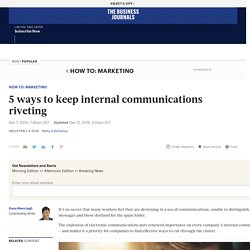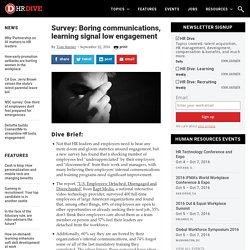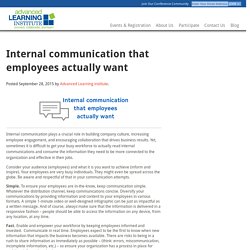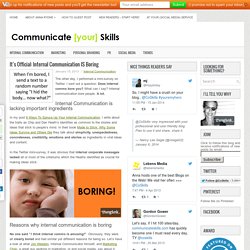

How internal comms can make your organisation agile and responsive. The business world is undergoing sweeping changes – organisations both large and small must factor new technologies, disruptive competitors and empowered customers into their plans.

To make the most of this dynamic business environment, organisations need to become agile and responsive. They must anticipate and adapt to changes in the marketplace, in consumer behaviour and in the technology that underpins their business – and react at speed. 5-ways-to-keep-internal-communications-riveting. Companies ignore the importance of communicating well internally at their peril.… more iStock (PeopleImages) It’s no secret that many workers feel they are drowning in a sea of communications, unable to distinguish between important messages and those destined for the spam folder.

The explosion of electronic communications puts renewed importance on every company’s internal communications function — and makes it a priority for companies to find effective ways to cut through the clutter. I spoke with Sarah Perry, CEO of SnapComms, an award-winning company that develops employee communications software. How a series of crises flipped Target's internal comms strategy on its head. Between late 2013 and early 2015, Target dealt with a data breach, a CEO transition, job cuts, and significant challenges in Canada.

Its employees also felt like they were out of the loop, learning more about their company from the media than they did at work, said Dustee Jenkins, SVP of communications at Target. "One of the key complaints from the team is that they were hearing so much about our own company in the press, but not hearing anything directly from the company in real-time about what was happening," she explained. Target’s internal communications consisted of a few stories posted on an intranet each week, covering mundane topics such as how to sign up for benefits or an employee’s experience in a target store. “Just yell duck! A lot of us died by the time you finished talking.” - Mindset Digital. By Debra Jasper and Betsy Hubbard We talk too much.

We write too much. Survey: Boring communications, learning signal low engagement. Dive Brief: Not that HR leaders and employers need to hear any more doom and gloom statistics around engagement, but a new survey has found that a shocking number of employees feel "underappreciated" by their employers and "disconnected" from their work and managers, with many believing their employers' internal communications and training programs need significant improvement.

The report, "U.S. Employees: Detached, Disengaged and Disenchanted" from Rapt Media, a national interactive video technology provider, surveyed 400 full-time employees of large American organizations and found that, among other things, 69% of employees are open to other opportunities or already seeking their next job, 35% don’t think their employers care about them as a team member or person and 57% feel their leaders are detached from the workforce. Additionally, 60% say they are are bored by their organization’s internal communications, and 74% forgot some or all of the last mandatory training they completed. Internal communication tips - Advanced Learning Institute. Internal communication plays a crucial role in building company culture, increasing employee engagement, and encouraging collaboration that drives business results.

Yet, sometimes it is difficult to get your busy workforce to actually read internal communications and consume the information they need to be more connected to the organization and effective in their jobs. Consider your audience (employees) and what it is you want to achieve (inform and inspire). Teeing Off: The Front Nine of Internal Communication - 27 Jul Teeing Off: The Front Nine of Internal Communication Picture a large corporation.

A corporation doesn’t like the game of golf. Sure- their associates, executives, and clients probably golf, but the corporation itself prefers their activity– the pursuit of progress and success– to move at the same pace I like my sports: momentum at a swift, more stimulating rate. Stepping onto the course of communication and cultural change, the corporation only sees laborious effort that they simply don’t have time for. Shifts in the way business units connect with one another take time, training, and tedious hours of attention to reforming communication habits. Topgolf: Teeing Off Last month I attended an intranet conference hosted by Igloo Software where our company’s founder, Andy Jankowski, was the keynote speaker. It’s Official: Internal Communication IS Boring. The other day, I performed a mini-survey on Twitter.

I sent out a question: Does Internal comms bore you? What can I say? Internal communication bore people. A lot. Setting the Stage for Effective Internal Communications. Given the increasing emphasis companies have placed on employee engagement, it’s little wonder that the role internal communications now plays in many organizations has so greatly expanded.

After all, communication is key to motivating workers and inspiring them to go above and beyond. As Emma Dale, co-founder and managing director at global recruitment firm Prospect, writes, “When done well, internal communications can help businesses achieve their long-term objectives — aligning employees with company values, creating a healthy corporate culture and cultivating internal brand advocates.” The Psychology of Color & Employee Communication. Defining your ideal Internal Communication operating model and organizational structure. With increasing pressure to be agile and strategically focused, today’s Internal Communication function must continue to shift in structure and orientation to suit.

Here we explore the broad spectrum of IC functional design, the attributes of different real-life operating models and organizational structures – and offer guidance on what to consider when defining your function. If your Internal Communication function is struggling to keep pace with change, you’re not alone. Before you turn down the noise, tune in and listen. More insights from our newest study. Is the issue of ‘noise’ less about volume, and more to do with complexity and context? Recent insights from Melcrum’s research team in our latest study indicate that information overload certainly has a smaller role – and the true IC challenge is how we tune into what’s really valuable. As Melcrum continues conversations with communication leaders to make sense of how noise affects our desire to align employee populations to one another, and to the corporate narrative, one thing is becoming clear; in the new world order, the problem of noise is less about volume, and more about complexity and context.
Using our power to turn noise down might help top down messages cut through, but it could also prevent us from learning new and beautiful things about the way our organizations operate, so that we can stay relevant to our audiences and the contexts they work in. Unlike a decade ago, information overload is a much smaller part of the problem of noise. Are Your Internal Communications Boring? A critical component to business success is an actively engaged workforce. And one way of almost guaranteeing you don’t have one is by producing dull internal communications (IC). If, when reading an article, you yawn before the second paragraph, what are the chances of you finishing it? Pretty slim, right? Well, the same goes for your staff when they’re skimming the weekly newsletters, email updates and intranet features. 6 Ways Internal Communications are Costing You Customers. In honest efforts to maintain control and efficiency within an organization, many business leaders fail to recognize the direct impact employees and internal culture have on the customer experience.
Internal communications – those notices, signs and emails we all receive as employees – are a huge part of that culture. Have you considered lately how the language you use internally affects the way information is delivered to your customers? It’s not just about saying what needs to be said: But how the people in your organization are saying it: How would you feel as the owner of this establishment, popping in for a long overdue visit? Would YOU know? We see the same approaches over and over again. Promoting Internal Communication. What is internal communication? Why promote internal communication? How do you promote internal communication? How do you monitor and improve internal communication? Worst-case scenario: It's 3:45 p.m., and your organization has scheduled a rally in favor of the new Youth Center at 4:00.
The press is there, the folks pushing the Youth Center are there, the politicians are there...where are all the people from your organization? Even-worse-case scenario: You're the director of a community health clinic, and you're about to open on Monday morning. Each of these situations results from poor communication within an organization. A lot of the information and suggestions in this section assume a staff of at least five or six members, which is the number at which sustaining internal communication can become particularly difficult.
Five simple tips for good internal communication. Content is king Start with a social intranet implementation, then add useful content. If the content is useful - you will automatically improve your internal communication skills; just by facilitating relevant content at the terms of your colleagues. Continuously remind everyone that a social intranet is a community effort, so there will always be others out there who can help make the information more clear if needed. The bottom line is to help others solve a problem or better understand an issue. If your information does that, then you've succeeded. How visual thinking maps can enhance internal communication. In a world where we’re bombarded with emails, updates, texts and tweets, communicating visually is one way your organization could rise above the noise and achieve real cut-through.
The 2 Reasons Internal Communications Is Different in the Public Sector « Results Map. A recent post by Melcrum posed an interesting question that generated a lot of Twitter buzz – does internal communication and engagement differ in the public sector from the private sector? 10 “Musts” for Internal Communications. Small Business HR: 6 Tips for Effective Employee Communication. Internal communication and the available brain time syndrom - Bertrand Duperrin's Notepad. Cast this Magic Spell For Crystal Clear Internal Comms Copy. Hey – want to learn a cool new trick? It’s a spell that I just wrote.
You can cast it on your staff to make sure they read what you write. Words and Phrases to be Banned, 2014 Edition. Posted on January 13, 2014 Filed Under Internal Communication, Media Relations, Social Media English has 1.1 million words, more words than any other language, according to the Global Language Monitor and other sources. It’s Official: Internal Communication IS Boring. “If I Find One Brown M&M, Tonight’s Concert is Cancelled” Employers need to ‘plug in’ to worker communications preferences—One of 3 things you need to know this week in employee benefits. Three Tips To Improve Your Employee Communications. Our employees are bombarded with messages every second of every day.
5 PR Tactics for Internal Communications. With the proliferation of social media channels, employees have become 24/7 brand ambassadors for their companies and the lines between internal and external communications are continuously blurring. Three tips for effective internal communication. Ian Cowley reveals some low-cost ways of connecting better with your employees. 33 Things to Ask Before Hitting Publish. The Best Length for Every Online Content. 18.7K Flares Filament.io 18.7K Flares × Every so often when I’m tweeting or emailing, I’ll think: Should I really be writing so much? I tend to get carried away. And for the times that I do, it sure would be nice to know if all this extra typing is hurting or helping my cause.
I want to stand out on social media, but I want to do it in the right way. Tips for communicating better with your employees. Headsmacking Tip #21: Write Better Headlines Than Anyone Else. The 7 C’s of Great Internal Communication. Small Business HR: 6 Tips for Effective Employee Communication. Ultimate list of online content readability tests. The science behind storytelling. Feedback and Lessons for Internal Communications « INTRASKOPE – INTERNAL COMMUNICATION VIEWPOINT FROM INDIA. The Inigo Montoya Guide to 27 Commonly Misused Words. 4 Ideas for More Effective Internal Communication. 4 pitfalls for effective Internal Communication delivery. Ten ways to make your news stories more memorable « The Creative Kitty. 5 Internal Communications Trends. 10 ways to improve your company’s internal communication - Unum. 48 Elements of Persuasive Written Content. Cross Cultural Communication. Watch the best ads of 2013 to improve employee communication in 2014. How to Write Headlines That Work.
Keep on yakkin’ — Authenticity in internal communication. Inner Strength Communication. Around the world in plain words. Internal communications isn’t uniform, it is contextual « Dynamic PR.
Why HR Struggles to Get Its Point Across. 10 Tips For Effective Employee Communication. 8 Steps to Stronger Organizational Communication. 3 Psychological Triggers that Can Move Your Audience from Indifference to Desire. MailChimp UX Issue 25 - Communication + Culture. 6 Ways To Spruce Up Your Internal Communication.